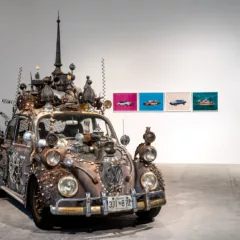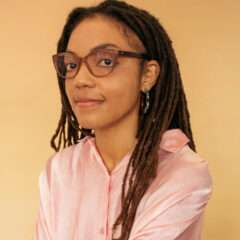Outsider Art and the Mainstream was held at the Philadelphia Museum of Art (PMA) on March 1-2 in conjunction with the opening of Great and Mighty Things; Outsider Art from the Jill and Sheldon Bonovitz Collection (on view through June 9, 2013). The large exhibition includes more than two hundred works by twenty-seven American artists, all of which have been promised to the museum, making the PMA a significant resource for art that, however uneasily, is generally termed outsider.
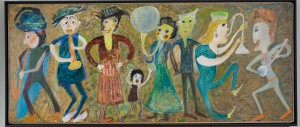
Whenever artists have tired of the deadening effects of academic art standards, they have looked elsewhere for art that they thought sprang more directly from the artists’ psyche, unhampered by artistic or social conventions. Since the early Nineteenth Century, this primitivism has encompassed an interest in Medieval art, art by children, by the mentally ill, by tribal peoples, and by individuals separated from the art community by virtue of their physical isolation, poverty, educational limitations, and various physical or mental disabilities. In 1922, the German psychiatrist, Hans Prinzhorn, published a book, Artistry of the Mentally Ill, which was avidly read by artists of the period. One of them was Jean Dubuffet, who became a major collector and champion of work by outsiders, which he termed Art Brut (Raw Art). A lecture he gave in Chicago in the 1950s spurred an interest among artists there. They, in turn, discovered and advocated for the work of outsiders such as Joseph Yoakum and Martin Ramirez (both included in the Bonovitz Collection, and high in the canon of outsider artists), whose vision contributed to their own artwork. A number of well-know outsider artists produced work as a calling and form of religious ministry, appreciation of which has rarely survived their acceptance within the mainstream art community.
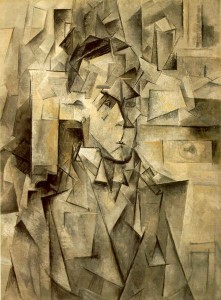
The symposium’s keynote address, given by Joe Rishel, Senior Curator at the PMA, looked at the place of the German dealer and collector, Wilhelm Uhde, in promoting the work of untrained artists in turn of 20th-century Paris. By 1904 when Uhde moved to Paris, Rousseau had already been taken up by Picasso, who held a famous banquet in his honor. Uhde wrote a book on Rousseau and after WWI, organized an exhibition of Rousseau and four other artists he termed naïf, which toured Europe and then traveled to the newly-established Museum of Modern Art, NY, which exhibited and collected work by untrained artists in the 1930s, under Alfred Barr.
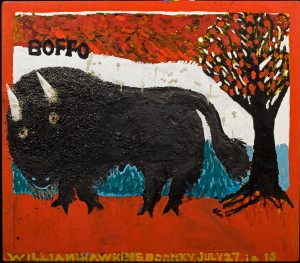
The subject of outsider art always provokes attention to terminology as well as boundary-drawing, in relation to folk art (considered traditional and communal, as opposed to the individual and personal work of outsiders) and the greater art world. Many people would like to see the entire category disappear and have the work treated as art, with no qualifier. Art historian and curator, Lynne Cooke thinks the term is demeaning, and has sought different models of dealing with the work. She described a recent project where she worked with Rosemary Troeckel to exhibit Troeckel’s work alongside that of outsider artists, other trained artists, and botanical and zoological illustrators. All were presented as equal sources of visual interest.

The sociologist, Anne Bowler commented that discussion of outsider artists’ biographies has overshadowed discussion of their aesthetics. She traced this to a founding myth of modernism’s oppositionality and the search for authenticity. A more useful approach, she suggested, would study the borders and boundaries of outsider art, without losing sight of the art objects – which, after all, provided the initial interest. John Ollman, an art dealer in Philadelphia with an unusually long history of exhibiting outsider art, emphasized the place of artists in championing the work of outsiders (not surprising, since the primitivising impulse sprang from their dissatisfaction with the art world in which they participated) and traced his own development in understanding the work. The meatiest presentation was given by Leslie Umberger, now curator at the Smithsonian American Art Museum. She gave case studies of her extensive experience, at the Kohler Art Center, curating exhibitions which presented outsiders on equal footing with trained artists. She discussed different ways in which she organized the exhibitions and analyzed their varying drawbacks and successes. While she sympathized with the impulse to treat the artists equally, she stressed that their work came from very different situations, and to ignore this was to disrespect both the circumstances of the outsider artists’ lives and questions of their identity. The sophistication of her presentation demonstrated that work done at a small art center in Sheboygan can have much to offer major museums (and made me regret that I had not known of her exhibitions as they occurred).
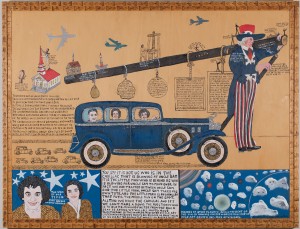
The afternoon was occupied with a panel discussion among Carlos Basualdo, curator at the PMA, Bernard L. Herman, Professor of American Studies at UNC, Colin Rhodes, Dean of Sydney College of Art and a scholar of outsider art, and Cara Zimmerman, director of the Foundation for Self-Taught Artists, N.Y. The conversation centered around the question of what exhibiting outsider art in mainstream museums meant to those institutions’ understanding of their own values and standards. This returned the discussion to the question with which Rishel had begun the symposium, Why is a collection of work of un-trained artists being held in the PMA’s primary exhibition galleries where we are accustomed to seeing work by artists such as Cezanne?


